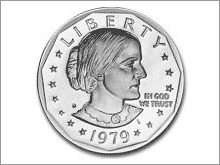 |
| America's sweetheart? Not exactly. |
|
|
|
|
|
NEW YORK (CNN/Money) -
Like lemmings rushing into the fjords, Congress cannot seem to resist a leap into the dollar-coin money pit.
Despite two wildly unsuccessful attempts to introduce a dollar coin, legislators are trying again.
On Wednesday, the House of Representatives passed a bill to create a new $1 coin, which would accompany the current Sacagawea piece. The measure enjoyed enormous bipartisan support, passing by a vote of 422 to 6.
Assuming a companion bill makes it through the Senate, the nation would be on its way to taking another stab at a dollar coin.
This time, however, lemmings might fly.
The Presidential $1 Coin Act was led in the House by Michael Castle (R-Del.) and Carolyn Maloney (D-N.Y.). In the Senate, shepherds are John Sununu (R-N.H.) and Minority Leader Harry Reid (D-Nev.).
Supporters realize that the dollar coin is the Rodney Dangerfield of American money. So they make clear that any new coin would augment -- not replace -- paper currency.
In fact, although the coins would enter into general circulation, their biggest selling point is that people might hoard them.
The idea steals a page from the popular 50 State Quarters series, in which the engraving on the 25-cent piece rotates to honor all the states. That legislation was also the brainchild of Rep. Castle.
The subjects depicted on the dollar coins would be the U.S. presidents. The plan is to introduce four new ones a year beginning in 2007, honoring each of the nation's chief executives in the order of their service.
After the 50 State series launched in the late 1990s, the government discovered that an astonishing number of people were collecting each new quarter as it rolled out of the U.S. Mint, taking the pieces out of circulation.
It costs the Mint less than five cents for each 25-cent piece it produces. So in a process called seigniorage, the government makes money whenever someone "buys" a coin then chooses not to spend it.
The Treasury estimates that it has earned about $5 billion in seigniorage profits from the quarters so far.
Proponents of a new dollar hope to build on that unexpected success by creating another coin with mass market appeal.
"The first goal is to increase collection and production of the dollar coin," says Elizabeth Wenk, a spokeswoman for Rep. Castle.
Vast public indifference
The recent history of the dollar coin in the United States is not a proud one.
In 1979, the Treasury Department introduced the Susan B. Anthony dollar, and produced nearly one billion of them between 1979 and 1981.
The Carter administration promoted it with a vengeance, calling it "the dollar of the future."
They hyped its cost-savings -- metal lasts much longer than paper, so you don't need to mint as often as you print.
They hyped its subject -- Anthony was the first woman (if you don't count Lady Liberty) to appear on U.S. money since the early 19th century.
They even hyped its design -- the 11-sided polygon (a hendecagon) was meant to mark a clear difference between the coin and all others.
Despite the fanfare, the public hated it. The Anthony dollar quickly became another quaint relic of the Seventies, like the AMC Pacer.
In 1999, Treasury made another attempt at a dollar coin. This time, it honored the Shoshone woman who helped guide Lewis and Clark across the West.
Boosters again made arguments about cost-savings and historical import. Americans again responded with vast national indifference.
Three years after its introduction, a General Accounting Office poll found that 97 percent of American had not used the coin within the past month, and that 74 percent could not remember ever using one.
History buffs should be happy
Although capitalism, not conservation, may be the best reason to act now, history buffs seem certain to be intrigued by the new series.
"In addition to their ability to generate money, these coins serve as integral markers of American history," said Castle in a statement.
For one thing, they will give some attention to such historical footnotes as William Henry Harrison and Millard Fillmore. For another, they could create a new partisan parlor game.
Republicans might snatch up Reagan and Teddy Roosevelt. Democrats might seek out Kennedy and FDR.
When the time comes to honor contemporary presidents, such as George W. Bush, Bill Clinton and their successors, their likenesses are to be minted whether they are living or dead.
That means by 2018 or so -- when Bush and Clinton would be in their early 70s -- the United States could break a long-standing tradition that money only honors the deceased.
------------------------
Currency flops through the ages. Click here for story.
Flashback: New nickels unveiled. Click here for story.
Treasury to mint new 24-karat gold coin. Click here for story.

|